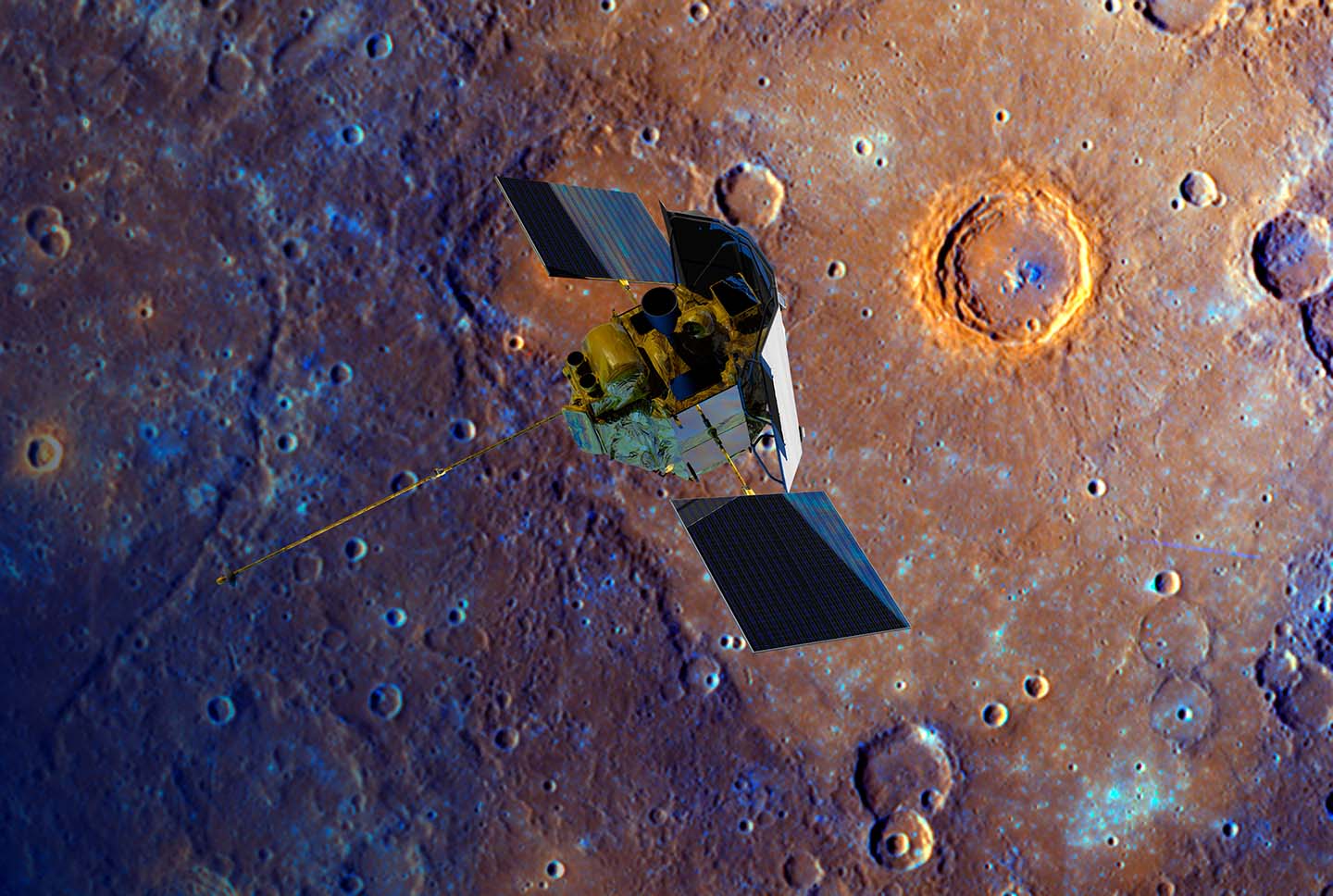Press Release
With the End in Sight, MESSENGER Marks Four Years at Mercury
Wed, 03/18/2015 - 14:18
On the evening of March 17, 2011 (EDT), the MESSENGER spacecraft — built and operated by the Johns Hopkins University Applied Physics Laboratory (APL) in Laurel, Maryland — made history when it became the first to orbit the innermost planet. Over the last four years, its instruments have fully mapped Mercury’s surface and yielded discoveries that have changed views on how the inner planets formed and evolved.
“MESSENGER truly is an extraordinary mission,” said Peter Bedini, a senior management advisor and former project manager for the mission. “When it began its primary mission four years ago, the spacecraft had already traveled almost five billion miles and completed six planetary encounters. During its pre-orbital Mercury flybys alone, MESSENGER collected as much data as Mariner 10 — the only other spacecraft ever to visit the innermost planet — and began addressing questions about Mercury that had remained unanswered for more than 30 years.”
“All objectives of the primary mission were easily met in the first year in orbit, and those findings stimulated questions that guided two successive extended missions,” added Bedini. The latest findings were discussed in 15 papers presented this week and highlighted in a press conference at the 46th Lunar and Planetary Science Conference in The Woodlands, Texas.
The mission has also contributed to NASA’s technology base, said David Grant, who served as the mission’s project manager for five years, overseeing the development, integration, testing, and launch of the spacecraft and subsequent mission operations, including the Earth flyby and two Venus flybys.
Grant offers two examples. MESSENGER is the first mission to utilize “solar sailing,” that is, to correct the trajectory of the spacecraft with the Sun’s radiation, saving propellant and extending mission operations. The project is also the first to use SciBox, an automated science planning and commanding tool, for all data acquisition. Given spacecraft operational constraints and instrument operational constraints and objectives, the tool provides the science planner with an optimized set of opportunities to take observations and produces an integrated command sequence for the payload.
“But there was one other first among equals: system engineering,” Grant said. “I believe that the integration of the entire system presented the greatest challenge and led to our greatest success. Andy Santo, James Leary, Eric Finnegan, and Dan O’Shaughnessy served sequentially as MESSENGER’s Mission Systems Engineers over a period spanning more than 15 years. Their performance was exceptional and really speaks for itself.”
Now, after MESSENGER has logged more than 10 years in flight, the spacecraft and science instruments remain remarkably healthy, but the propulsion system is running on fumes. The force of solar gravity continues to perturb the spacecraft orbit in a manner that drives the probe downward toward the planet’s surface with each closest approach, and the tanks of propellant — needed to boost the spacecraft to higher altitudes — are running dry. On March 18, the team will conduct the first of five final orbit-correction maneuvers designed to keep MESSENGER in orbit up to four weeks longer, possibly as late as April 30.
“The success of MESSENGER is a direct result of the talent and dedication of the team that designed and built it more than a decade ago, and of those who have operated it and directed the science data collection since launch in 2004,” said Helene Winters, MESSENGER’s current project manager. “The results of this Discovery-class mission have rewritten the book on Mercury and filled an important gap in our understanding of our Solar System.”
MESSENGER (MErcury Surface, Space ENvironment, GEochemistry, and Ranging) is a NASA-sponsored scientific investigation of the planet Mercury and the first space mission designed to orbit the planet closest to the Sun. The MESSENGER spacecraft was launched on August 3, 2004, and was inserted into orbit about Mercury on March 18, 2011 (UTC), to begin its primary mission — a yearlong study of its target planet. MESSENGER’s first extended mission began on March 18, 2012, and ended one year later. MESSENGER is now in a second extended mission, which is scheduled to conclude this spring. Sean C. Solomon, the Director of Columbia University’s Lamont-Doherty Earth Observatory, leads the mission as Principal Investigator. The Johns Hopkins University Applied Physics Laboratory built and operates the MESSENGER spacecraft and manages this Discovery-class mission for NASA.
